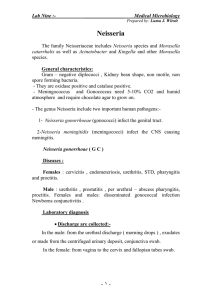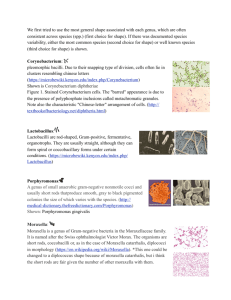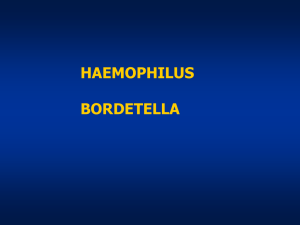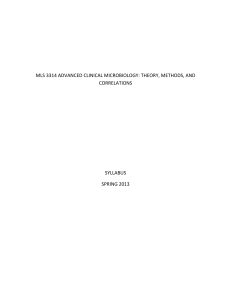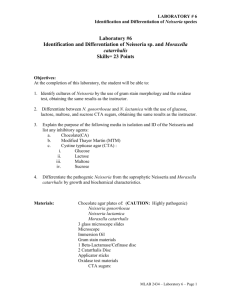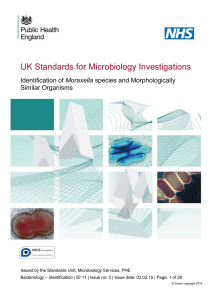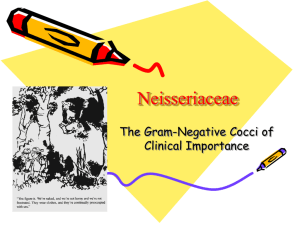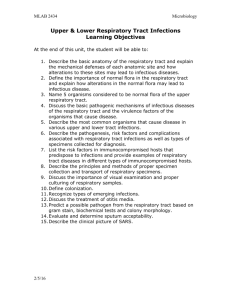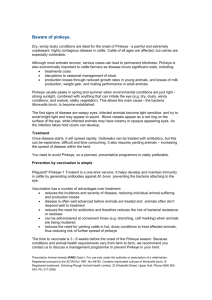Document 13310083
advertisement
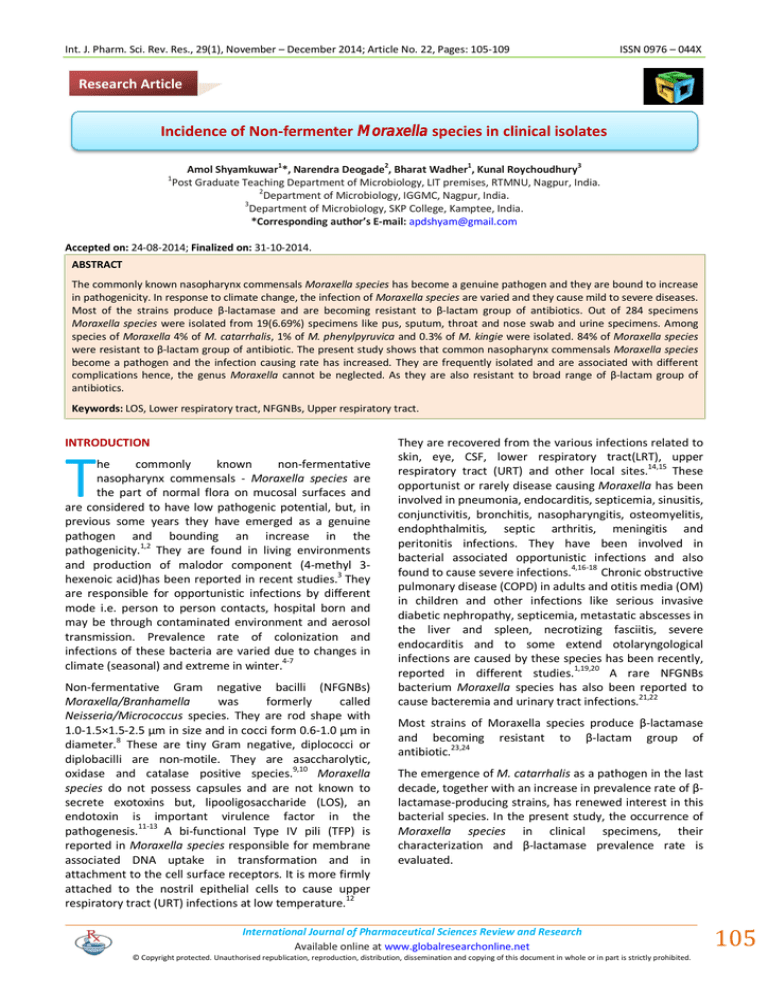
Int. J. Pharm. Sci. Rev. Res., 29(1), November – December 2014; Article No. 22, Pages: 105-109 ISSN 0976 – 044X Research Article Incidence of Non-fermenter Moraxella species in clinical isolates 1 1 2 1 3 Amol Shyamkuwar *, Narendra Deogade , Bharat Wadher , Kunal Roychoudhury Post Graduate Teaching Department of Microbiology, LIT premises, RTMNU, Nagpur, India. 2 Department of Microbiology, IGGMC, Nagpur, India. 3 Department of Microbiology, SKP College, Kamptee, India. *Corresponding author’s E-mail: apdshyam@gmail.com Accepted on: 24-08-2014; Finalized on: 31-10-2014. ABSTRACT The commonly known nasopharynx commensals Moraxella species has become a genuine pathogen and they are bound to increase in pathogenicity. In response to climate change, the infection of Moraxella species are varied and they cause mild to severe diseases. Most of the strains produce β-lactamase and are becoming resistant to β-lactam group of antibiotics. Out of 284 specimens Moraxella species were isolated from 19(6.69%) specimens like pus, sputum, throat and nose swab and urine specimens. Among species of Moraxella 4% of M. catarrhalis, 1% of M. phenylpyruvica and 0.3% of M. kingie were isolated. 84% of Moraxella species were resistant to β-lactam group of antibiotic. The present study shows that common nasopharynx commensals Moraxella species become a pathogen and the infection causing rate has increased. They are frequently isolated and are associated with different complications hence, the genus Moraxella cannot be neglected. As they are also resistant to broad range of β-lactam group of antibiotics. Keywords: LOS, Lower respiratory tract, NFGNBs, Upper respiratory tract. INTRODUCTION T he commonly known non-fermentative nasopharynx commensals - Moraxella species are the part of normal flora on mucosal surfaces and are considered to have low pathogenic potential, but, in previous some years they have emerged as a genuine pathogen and bounding an increase in the pathogenicity.1,2 They are found in living environments and production of malodor component (4-methyl 3hexenoic acid)has been reported in recent studies.3 They are responsible for opportunistic infections by different mode i.e. person to person contacts, hospital born and may be through contaminated environment and aerosol transmission. Prevalence rate of colonization and infections of these bacteria are varied due to changes in 4-7 climate (seasonal) and extreme in winter. Non-fermentative Gram negative bacilli (NFGNBs) Moraxella/Branhamella was formerly called Neisseria/Micrococcus species. They are rod shape with 1.0-1.5×1.5-2.5 µm in size and in cocci form 0.6-1.0 µm in diameter.8 These are tiny Gram negative, diplococci or diplobacilli are non-motile. They are asaccharolytic, oxidase and catalase positive species.9,10 Moraxella species do not possess capsules and are not known to secrete exotoxins but, lipooligosaccharide (LOS), an endotoxin is important virulence factor in the 11-13 pathogenesis. A bi-functional Type IV pili (TFP) is reported in Moraxella species responsible for membrane associated DNA uptake in transformation and in attachment to the cell surface receptors. It is more firmly attached to the nostril epithelial cells to cause upper respiratory tract (URT) infections at low temperature.12 They are recovered from the various infections related to skin, eye, CSF, lower respiratory tract(LRT), upper respiratory tract (URT) and other local sites.14,15 These opportunist or rarely disease causing Moraxella has been involved in pneumonia, endocarditis, septicemia, sinusitis, conjunctivitis, bronchitis, nasopharyngitis, osteomyelitis, endophthalmitis, septic arthritis, meningitis and peritonitis infections. They have been involved in bacterial associated opportunistic infections and also found to cause severe infections.4,16-18 Chronic obstructive pulmonary disease (COPD) in adults and otitis media (OM) in children and other infections like serious invasive diabetic nephropathy, septicemia, metastatic abscesses in the liver and spleen, necrotizing fasciitis, severe endocarditis and to some extend otolaryngological infections are caused by these species has been recently, 1,19,20 reported in different studies. A rare NFGNBs bacterium Moraxella species has also been reported to cause bacteremia and urinary tract infections.21,22 Most strains of Moraxella species produce β-lactamase and becoming resistant to β-lactam group of antibiotic.23,24 The emergence of M. catarrhalis as a pathogen in the last decade, together with an increase in prevalence rate of βlactamase-producing strains, has renewed interest in this bacterial species. In the present study, the occurrence of Moraxella species in clinical specimens, their characterization and β-lactamase prevalence rate is evaluated. International Journal of Pharmaceutical Sciences Review and Research Available online at www.globalresearchonline.net © Copyright protected. Unauthorised republication, reproduction, distribution, dissemination and copying of this document in whole or in part is strictly prohibited. 105 © Copyright pro Int. J. Pharm. Sci. Rev. Res., 29(1), November – December 2014; Article No. 22, Pages: 105-109 MATERIALS AND METHODS ISSN 0976 – 044X matrix (a prior probability) and test results (a posterior probability) were fed in the identification of nonfermenter Moraxella species. The algorithm used 1 for each bacterial identification test which would be the respected frequency of incidence of strains in the matrix (ti). So, the modified formula used in the algorithm is: A total of 284 clinical specimens were processed for culture by standard technique and isolates were screened 25 to identify the Moraxella species. Screening of Non-fermentative Moraxella species ( )= Isolates from clinical specimens i.e. pus, urine, sputum and conjunctiva swab were characterized by using Blood agar, MacConkey agar & TSI agar. Oxidative fermentation (OF) of glucose and cytochrome oxidase production were also studied. ( )/ () So, the final score (the posteriori probability) of the taxon ti is its probability of being consistent with the given results, but normalized using all other taxa probabilities. Antibiotic sensitivity pattern Species characterization Antibiotic sensitivity of Penicillin G was done by KirbyBauer disk diffusion method to detect the β-lactam resistant strains of Moraxella species on Muller-Hinton 27 agar. Penicillin G is active against Moraxella & used in the identification of taxon but, the antibiotic is rarely resistant. All the primarily identified Moraxella species were subjected to characterization upto genus identification by conventional systems. Motility at 370C, pigment production, enzyme production (catalase, urease, 0 gelatinase, DNAse), growth at 42 C, nitrate or nitrite reduction, arginine dihydrolase, lysine decarboxylase, citrate utilization, indole production and OF (sucrose/lactose/mannitol/xylose/fructose) tests were done. RESULTS AND DISCUSSION iЄtaxa In this study the 284 specimens were studied from different patients. 19(6.69 %) Moraxella species were isolated from clinical specimens. Maximum, 19.05 % and 17.5 % of the isolates were from the sputum and throat swabs respectively. A proportion 5.56 % and 4.92 % of Moraxella species were isolated form nasal swabs and urine sample respectively. Only, one M. catarrhalis was isolated from pus sample. The percent frequency is shown in Table 1. P (ti|R) is the (posteriori) probability that an unknown isolate can be really a member of taxon ti, given the pattern of tests results R. The isolates were characterized by conventional method and Bayes’ matching percent for confirmation of Nonfermenters is listed in Table 2. P (R|ti) is the (prior) probability that the unknown has a pattern R considering that it is a member of taxon ti. Among Moraxella species, M. catarrhalis was isolated with higher frequency rate i.e. 4.93% (14/284), followed by M. Phenylpyruvica (1.41%) and M. kingie (0.3%) and their incidence in this study is shown in Table 3. Statistics (Bayes’ probability theorem) Bayes' probability was used to reach at an accurate taxon on the basis of prior and posterior probabilities by following formula: ( ⃓ ) = ( ⃓ ) ( )/ ( ⃓ ) ( ) P (ti) would be the expected frequency of incidence of strains.26 Similarly, the overall prevalence rate of β – lactamase was 84% in Moraxella species but, high rate in M. catarrhalis and M. kingie were found while, low rate of resistance against penicillin-G was found in M. phenylpyruvica is also listed in Table 3. Identax Bacterial Identifier v1.0 Non-fermentative Gram negative bacilli were identified by Identax. According to Bayes’ probability theorem, the algorithm was developed and it containing GNANFROD Table 1: Occurrence of Moraxella species in different clinical specimens and their percent Specimens (n = 284) (Mac, TSI, OF) 1 2 3 Total (Mac, TSI, OF) 1 2 3 Total Percent Pus (n=78) + +++ +++ 75 - - - 01 1.33 % Urine (n=76) - +++ +++ 72 - - - 04 5.56 % Nasal swab (n=64) - ++ +++ 61 - - - 03 4.92 % Throat swab (n=41) - +++ +++ 40 + - - 07 17.5 % Sputum (n=25) - ++ +++ 21 + - - 04 19.05 % 19 6.69 % Total (n = 284) Fermenters 269 NFGNBs 1 – MacConkey, 2 – Triple Sugar Iron agar, 3 – OF glucose 99 % Negative/Alkaline, + 60% positive/Acid, ++ 75% positive/Acid, +++ 90% positive/Acid. International Journal of Pharmaceutical Sciences Review and Research Available online at www.globalresearchonline.net © Copyright protected. Unauthorised republication, reproduction, distribution, dissemination and copying of this document in whole or in part is strictly prohibited. 106 © Copyright pro Int. J. Pharm. Sci. Rev. Res., 29(1), November – December 2014; Article No. 22, Pages: 105-109 ISSN 0976 – 044X Table 2: Characterization of NFGNBs Moraxella species and Bayes’ matching percent Test Clinical specimens Nose 3 Total no. of specimens PUS 1 Urine 4 1 6 Sputum 4 Gram stain Morphology 0 Motility at 37 C 0 Growth at 37 C Pigment Negative Growth on MacConkey DC + + - DC + + - DC + + - DC + + - DC + + - DC + + - Catalase Cytochrome oxidase H&L –ve/Alk Nitrate reduction Gelatin + + - + + - + + - + + - + + - + + - AD LD DNAse Maltose Mannitol - - - - - - Growth at 42 C Heamolysis 4 - 6.5% NaCl Indole Citrate NS - NS - NS - + NS + NS - NS - Urease H2S TSI Glucose Xylose Starch - - - - - - Lactose Sucrose ONPG Acetamide Nonfermenters taxa identified as per the standard tables (Koneman et al & Bhujwala) V V V V V V Moraxella catarrhalis Moraxella phenylpyruvica Moraxella catarrhalis Moraxella kingie Moraxella catarrhalis Moraxella catarrhalis Moraxella sp.94.02% Moraxella sp.92.16% Moraxella sp.92.16% Moraxella kingie 98.62% Moraxella sp. 92.03% Moraxella sp. 92.10% 0 Bayes’ taxa matching percent (mean) Table 3: Overall percent of Moraxella species in total specimens processed and their Penicillin G (β-lactam) resistance (%). Species Identified No. % isolates Resistant No. Percent resistant M. catarrhalis 14 4.93 % 13 92.86% M. phenylpyruvica 04 1.41 % 02 50.00% M. kingie 01 0.3 % 01 100% Total: 284 19 6.69% 16 84.21% Throat CONCLUSION In case of Moraxella species a seasonal and geographic regional variations could be potential factors for this species to become a pathogen. Similarly, the genetic switch-over could be responsible to make Moraxella species as a pathogens and it is the part of intense research. Due to the two most common diseases (COPD & OM), UTI and other infections associated with Moraxella they are emerged as β–lactam resistant pathogens. International Journal of Pharmaceutical Sciences Review and Research Available online at www.globalresearchonline.net © Copyright protected. Unauthorised republication, reproduction, distribution, dissemination and copying of this document in whole or in part is strictly prohibited. 107 © Copyright pro Int. J. Pharm. Sci. Rev. Res., 29(1), November – December 2014; Article No. 22, Pages: 105-109 In the clinical bacterial study 2-7% Moraxella species from adults had been reported by Di Giovanni C et al.28 Similarly, many researchers have given variable range of 29,30 findings of Moraxella species in their studies. In the present study 6.69% of different Moraxella species were isolated from pus, urine, nasal &throat swab and sputum specimens. The finding of our study is in tune with the findings of Di Giovanni C et al.28 Fung CP & Snell JJS reported the majority of isolates are from sputum, four isolates from throats, three isolates from wounds i.e. pus and one isolate from urine. But, our findings are in contrast with Fung CP et al., and Snell JJS et al. As, 4(19.05 %), 7(17.5 %), 4(5.56%) and 1(1.33%) number of the isolates were isolated from the sputum, throat swab, urine and pus sample respectively.31,32 However, in the study related to upper respiratory tract (nasal swab) our study is differing with other findings due to the geographical region and seasonal variations. Our findings of Moraxella species was 4.92% which is higher than the study of Moraxella prevalence in nose reported by Di Giovanni C et al., 2.4 %.28 Tharne et al reported 9% of β-lactamase producing M. catarrhalis while; in the present study 4% of M. catarrhalis produces β–lactamase was isolated from clinical specimens. It showed a lower rate than the previous study of similar pathogens.33 these pathogens can not to be neglected. The studies on Moraxella species and their resistance pattern should be evaluated to show the risk factors of these species cannot be ignored as commensals. REFERENCES 1. BrittainCJ, Penwarden A, MearzaA, VerityD, Moraxella as a cause of necrotizing fasciitis of the eyelid, Eye, 20, 2006, 1312-14. 2. Enright MC, and McKenzie H, Moraxella (Branhamella) catarrhalis-clinical and molecular aspects of a rediscovered pathogen, Journal of Medical Microbiology, 46(5), 1997, 360-71. 3. Kubota H, Mitani A, Niwano Yu, Takeuchi K, Tanaka A, Yamaguchi N, KawamuraY, HitomiJ, Moraxella species are primarily responsible for generating malodor in laundry, Applied and Environmental Microbiology, 78(5), 2012, 3317-24. 4. Van Hare GF, ShurinPA, The increasing importance of Branhamella catarrhalis in respiratory infections, The Pediatric Infectious Disease Journal, 6(1), 1987, 92-94. 5. Mbaki N, Rikitomi N, Nagatake T, MatsumotoK, Correlation between Branhamella catarrhalis adherence to oropharyngeal cells and seasonal incidence of lower respiratory tract infections, The Tohoku Journal of Experimental Medicine, 153(2), 1987, 111-21. 6. Sarubbi FA, Myers JW, Williams JJ, Shell CG, Respiratory infections caused by Branhamella catarrhalis: selected epidemiologic features, The American Journal of Medicine, 88(5A), 1990, 9-14. 7. Hendley JO, Hayden FG, Winther B, Weekly point prevalence of Streptococcus pneumoniae, Hemophilus influenzae and Moraxella catarrhalis in the upairways of normal young children: effect of respiratory illness and season, acta pathologica, microbiologica et immunologica scadinavica, 113(3), 2005, 213-20. 8. Garrity GM, Brenner DJ, Krieg NR, Staley JT, Bergey's nd Manual of Systematic Bacteriology, 2 ed, Springer, New York, 2005. 9. Jawetz E, Melnich JL, Adelberg EA, Review of Medical th Microbiology, 12 ed., Lange Medical Publications, Los Atlos, Calif, 1976, 183. 10. Ninane G, Joly J, Piot P, Kraytman M, Letter, Lancet, ii, 1997, 149. 11. Mawas F, Ho MM, Corbel MJ, Current progress with Moraxella catarrhalis antigens as vaccine candidates, Expert Review of Vaccines, 8(1), 2009, 77-90. 12. Spaniol V, Troller R, Aebi C, Physiologic cold shock increases adherence of M. catarrhalis to and secretion interleukin 8 in human upper respiratory tract epithelial cells, Journal of Infectious Diseases, 200(10), 2009, 1593-1601. 13. Peng D,Hong W, Choudhury BP, Carlson RW, Gu XX M, catarrhalis bacterium without endotoxin, a Potential Vaccine candidate, Infection and Immunity, 73(11), 2005, 7569-77. 14. Tonjum T, Caugant DA, Bovre K, Differentiation of Moraxella nonliquefaciens, M. lacunata and M. bovis by 1.41% of M. phenylpyruvica was isolated in our study, while, it was reported by Guttigoli A et al., in their case study.34 Lowest percent of M. kingie (0.31%) was isolated in our study while, Henrikson et al., reported 1% of M. kingie. In the present study overall prevalence rate of β – lactam resistance in Moraxella species was 84%. Among Moraxella species the beta lactam resistance rates were 92% in M. catarrhalis, 50% in M. phenylpyruvica and single M. kingie was also resistant to beta lactam. Nana Tharne et al reported overall 91% prevalence rate of β – lactamase in M. catarrhalis which correlate with our findings.33 Snell JJS et al., reported the 37% of M. phenylpyruvica resistant to penicillin in their study which 32 is slightly lower than our findings. M. kingie resistant to β-lactam has been reported by Sordillo et al., which is correlated with the present findings.36 It has been seen from overall study that the nonfermenter M. phenylpyruvica isolation rate is increasing in clinical specimens. Similarly, the production of β-lactamase has been reported rarely in Moraxella species other than M. catarrhalis. Most Moraxella strains are susceptible to penicillin and its derivatives, cephalosporins, tetracyclins, quinolones and aminoglycosides. But, the present study indicates that the Moraxella species are becoming resistant to β-lactam group of antibiotic. The risk factor associated with animate and inanimate objects and other diseases of ISSN 0976 – 044X International Journal of Pharmaceutical Sciences Review and Research Available online at www.globalresearchonline.net © Copyright protected. Unauthorised republication, reproduction, distribution, dissemination and copying of this document in whole or in part is strictly prohibited. 108 © Copyright pro Int. J. Pharm. Sci. Rev. Res., 29(1), November – December 2014; Article No. 22, Pages: 105-109 ISSN 0976 – 044X using multilocus enzyme electrophoresis and hybridization with pilin-specific DNA probes, Journal of Clinical Microbiology, 30(12), 1992, 3099-3107. 26. Wilcox WR, LaPage SP, Bascomb S, Curtis MA, Identification of bacteria by computer: Theory and programming, Journal of General Microbiology, 77(2), 1973, 317-30. 15. Laukeland H, Bergh K, Bevanger L, Post trabeculectomy endophtalmitis caused by Moraxella nonliquefaciens, Journal of Clinical Microbiology, 40(7), 2002, 2668-70. 27. 16. Johnson DW, Lum G, NimmoG, Moraxella nonliquefaciens septic arthritis in a patient undergoing hemodialysis, Clinical Infectious Diseases, 21(4), 1995, 1039-40. Clinical Laboratory Standards Institute (CLSI), Performance th standards for antimicrobial susceptibility testing: 17 informational supplement M100-S17, Clinical and Laboratory Standards Institute, Wayne, 2007. 28. Di Govanni C, Riley TV, Hoyne GF, Yeo R, Cooksey P, Respiratory tract infections due to Branhamella catarrhalis: epidemiological data from western Australia, Epidemiology and Infection, 99(2), 1987, 445-53. 29. Doern GV, Morse SA, Branhmella (Neisseria) catarrhalis for lab identification, Journal of Clinical Microbiology, 11(2), 1980, 193-95. 30. Jakubicz P, Leszenska K, Occurrence of Moraxella catarrhalis in patients with respiratory tract infection, Medycyna doswiadczalna i mikrobiologica, 49(1-2), 1997, 55-60. 31. Fung CP, Jang TN, Lieu CY, Lau YJ, LiuYC, Chuang YC, LeeN, Antimicrobial susceptibility and β-lactamase production of Moraxella catarrhalis isolates in Taiwan, Journal of the Formosan Medical Association, 94(9), 1995, 548-54. 32. Snell JJS, Hill LR, Lapage SP, Identification and characterization of Moraxella phenylpyruivca, Journal of Clinical Pathology, 25(11), 1972, 959-65. 33. Abdolrasouli A, Aligholi M, Hemmati Y,Quinolone resistance in O. urethralis associated urinary tract infection, Iranian Journal of Pharmacology & Therapeutics, 5(1), 2006, 83-85. Tharne N, Olesen C, Sorensen HT, Schonheyder HC, Individual use of antibiotics and prevalence of betalactamase production among bacterial pathogens from middle ear fluid, Journal of Antimicrobial Chemotherapy, 47(2), 2001, 211-14. 34. Murphy TF, Branhamella catarrhalis epidemiology, surface antigenic structure and immune response, Microbiological Reviews, 60(2), 267-79. Guttigoli A, Zaman MM, Bacteremia and possible endocarditis caused by Moraxella phenylpyruvica, Southern Medical Journal, 93(7), 2000, 708-09. 35. Verduin CM, Hol C, FleerA, Dijk HV, Belkum AV, Moraxella catarrhalis: from emerging to established pathogen, Clinical Microbiology Review, 15(1), 2002, 125-44. Henrikson SD, Corroding bacteria from the respiratory tract 1. Moraxella kingii, Acta Pathol Microbiol Scand, 75(1), 1969, 85-90. 36. Sordillo EM, Rendel M, Sood R, Belinfanti J, Murray O, Brook D, Septicemia due to beta-lactamase-positive Kingella kingae [letter], Clinical Infectious Diseases, 17(4), 1993, 818-19. 17. 18. 19. 20. 21. 22. 23. 24. 25. Han XY, Tarrand JJ, Moraxella osloensis blood and catheter infections during anticancer chemotherapy: clinical and microbiologic studies of 10 cases, American Journal of Clinical Pathology, 121(4), 2004, 581-87. Shah SS, Ruth A, Infection due to Moraxella osloensis: case report and review of the literature, Clinical Infectious Diseases, 30(1), 2000, 179-81. Ray U, Kar S, Invasive infection due to Moraxella lacunata, an unusual pathogen, Southeast Asian Journal of Tropical Medicine and Public Health, 37(6), 2006, 1183-86. SuzukiK, Bacteria isolated from chronic upper and lower respiratory tract infections and the associated therapeutic strategies-in paranasal sinusitis, The Journal of the Japanese Association for Infectious Diseases, 80(1), 2006, 13-18. Seetha KS, BairyI, Shivananda PG, Bacteraemia in high-risk patients, Indian Journal of Medical Science, 56(8), 2002, 391-96. WinnW, Allen S, Janda W, Koneman E, Procop G, Schreckenberger P, Non fermenting gram negative bacilli. In: Koneman’s Color atlas and textbook of diagnostic th microbiology, 6 ed., Lippincott Williams and Wilkins company, USA, 2006, 305-91. Source of Support: Nil, Conflict of Interest: None. International Journal of Pharmaceutical Sciences Review and Research Available online at www.globalresearchonline.net © Copyright protected. Unauthorised republication, reproduction, distribution, dissemination and copying of this document in whole or in part is strictly prohibited. 109 © Copyright pro
